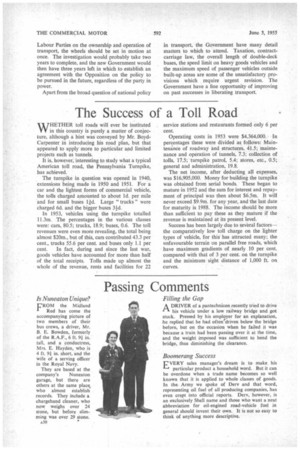Passing Comments
Page 32

Page 33

If you've noticed an error in this article please click here to report it so we can fix it.
Is Nuneaton Unique?
L'ROM the Midland I Red has come the accompanying picture of two members of their bus crews, a driver, Mr. B. E. Bowden, formerly of the R.A.F., 6 ft. 91 in. tall, and a conductress, Mrs. E. Hayden, who is 4 ft. 91 in. short, and the wife of a serving officer in the Royal Navy.
They are based at the company's Nuneaton garage, but there are others at the same place, who almost establish records. They include a chargehand cleaner, who now weighs over 24 stone, but before slimming was over 29 stone.
A30
Filling the Gap
ADRIVER of a pantechnicon recently tried to drive his vehicle under a low railway bridge and got stuck. Pressed by his employer for an explanation, he replied that he had often'driven below the bridge before, but on the occasion when he failed it was because a train had been passing over it at the time, and the weight imposed was sufficient to bend the bridge, thus diminishing the clearance.
Boomerang Success
VERY sales manager's dream is to make his particular product a household word. But it can be overdone when a trade name becomes so well known that it is applied to whole classes of goods. In the Army we spoke of Dery and that word, representing oil fuel of all producing companies, has even crept into official reports. Derv, however, is an exclusively Shell name and those who want a neat abbreviation for oil-engined road-vehicle fuel in general should invent their own. It is not so easy to think of anything more descriptive.
Two Spirited Films
PUBLIC interest in road development is almost certain to be aroused by the new Esso Petroleum film, "Highways for Tomorrow." The opening sequences of this illustrate how the drive to mechanize industry has considerably raised production, but how many of the advantages of this are lost, as the result of the delays which occur once the goods leave the factories.
These numerous obstructions caused by the present congested and inadequate road system, involve wastage of valuable time and fuel, unnecessarily high running costs, and additional wear on tyres, brakes and drivers' nerves.
The film, which runs for lzti minutes, ends with scenes of modern motorways under construction in Europe, and which are envisaged under the road development'programme in this country.
A second new film, shown recently by this company, " Refinery at Work," illustrates and explains the basic processes of three of the principal refinery operations—simple distillation, catalytic cracking and polymerization. Colour animation, combined with black and white shots of the Esso Refinery, Fawley, demonstrate the " inside" of the refinery plant.
Both films are available free, on loan, from the Esso Petroleum Co., Ltd., 36 Queen Anne's Gate, London, S.W.1.
Tubeless Tyres for Heavy Vehicles
GREAT confidence in the future of tubeless -tyres was expressed to a large party of members of the Institute of Road Transport Engineers who recently visited the Firestone factory, Great West Road, Brentford.
It was considered that these tyres would soon be available for commercial vehicles, in which, of course, several difficulties have to be overcome, as, on the heavier vehicles, the present methods of securing tyres are quite different from those employed on cars and light vans.
The party was most impressed by the excellent equipment employed in the building of tyres of all sizes, up to those for earth movers. Much of the construction is mechanized, and the machine shop not only produces the intricately patterned moulds but also makes many of the special tools needed.
It was interesting to learn that the inner lining of a Firestone tubeless tyre requires more rubber than is used in a normal inner tube for the size concerned.
The visit concluded with the showing of some excellent films, including one of tests with tubeless tyres carried out by "hell drivers," the vehicles so fitted being cornered or skidded right round with the tyres much below their normal pressure and at speeds up to 60 m.p.h. In no case did they leave the rims or burst, although some rolled on their side walls.




































































































